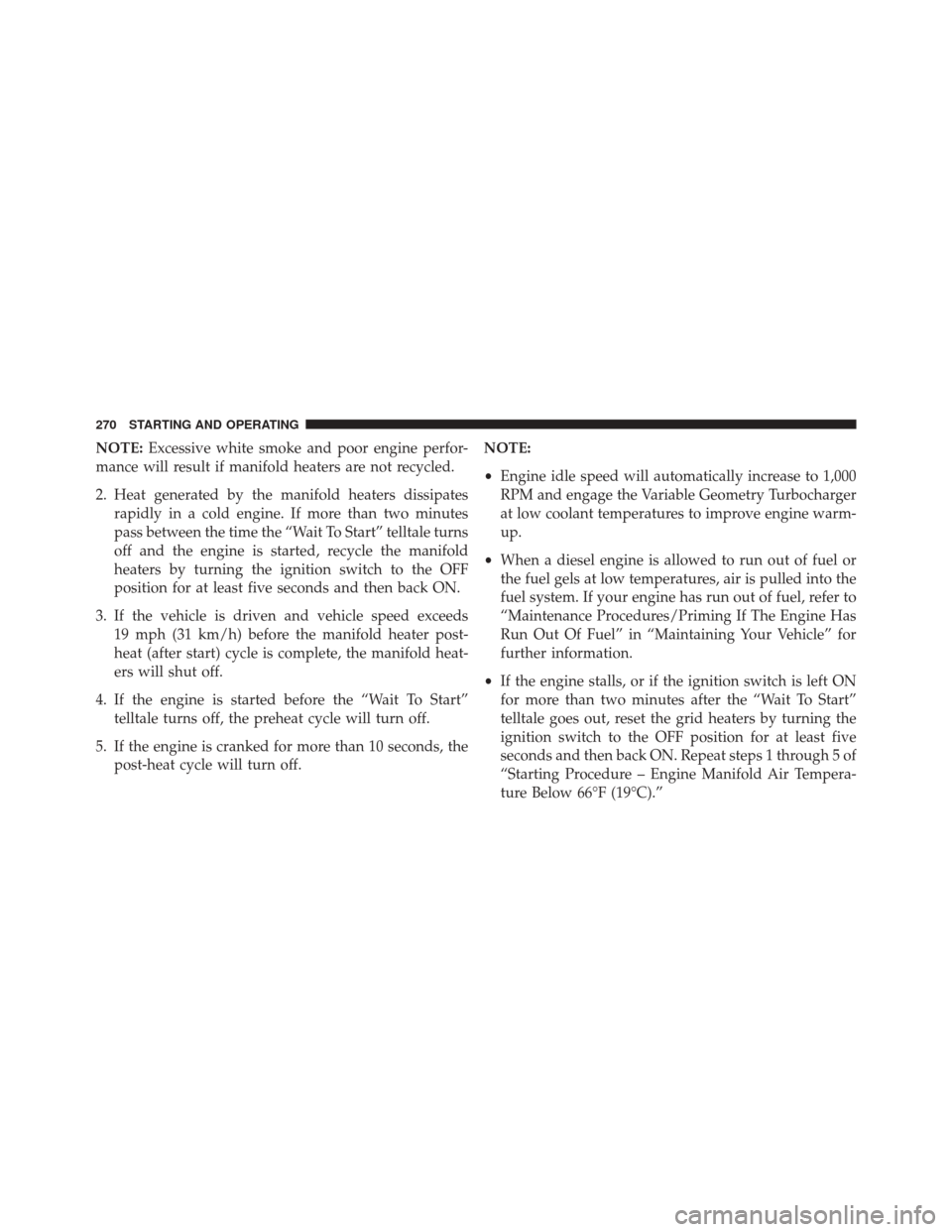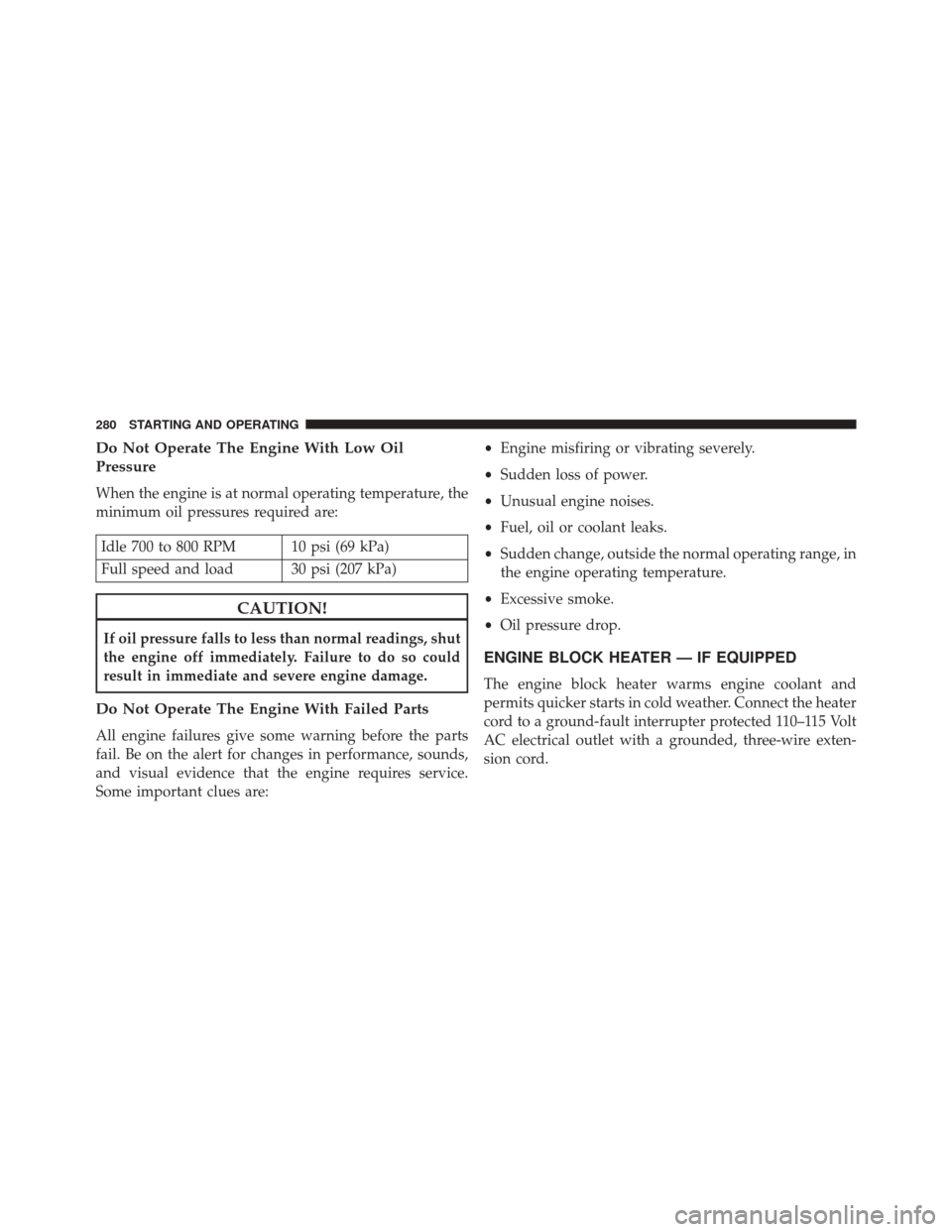Page 268 of 406

•A 12 Volt heater built into the fuel filter housings aid in
preventing fuel gelling. It is controlled by a built-in
thermostat.
• A heated intake air system both improves engine
starting and reduces the amount of white smoke
generated by a warming engine.
Normal Starting Procedure — Engine Manifold Air
Temperature Above 66° F (19° C)
Observe the instrument panel cluster lights when starting
the engine.
1. Always apply the parking brake.
2. Shift into PARK for an automatic transmission. For vehicles equipped with a manual transmission, fully
press and hold the clutch pedal and shift into NEU-
TRAL. 3. Turn the ignition switch to the ON position and watch
the instrument panel cluster lights.
CAUTION!
If the “Water in Fuel Indicator Light” remains on, DO
NOT START the engine before you drain the water
from the fuel filters to avoid engine damage. Refer to
“Maintenance Procedures/Draining Fuel/Water Sepa-
rator Filter” in “Maintaining Your Vehicle” for fur-
ther information.
4. Turn the ignition switch to the START position and crank the engine. Do not press the accelerator during
starting.
266 STARTING AND OPERATING
Page 269 of 406

CAUTION!
Do not crank engine for more than 15 seconds at a
time or starter motor damage may result. Turn the
ignition switch to the OFF position and wait at least
two minutes for the starter to cool before repeating
start procedure.
5. When the engine starts, release the key fob.
6. Check that the oil pressure warning light has turned off.
7. Release the parking brake.
Starting Procedure — Engine Manifold Air
Temperature 0°F To 66°F (–18°C to 19°C)
NOTE: The temperature displayed in the Electronic
Vehicle Information Center (EVIC) or Driver Information
Display (DID) does not necessarily reflect the engine
manifold air temperature. Refer to “Electronic Vehicle
Information Center (EVIC)” or “Driver Information Dis-
play (DID)” in “Understanding Your Instrument Panel”
for further information. When engine temperatures fall
below 66°F (19°C) the “Wait To Start Light” will remain
on indicating the intake manifold heater system is active.
Follow the steps in the “Normal Starting” procedure
except:
1. The “Wait To Start” telltale will remain on for a period of time that varies depending on the engine tempera-
ture.
5
STARTING AND OPERATING 267
Page 270 of 406

2. While the�Wait To Start” telltale is on, the EVIC/DID
will additionally display a gauge or bar whose initial
length represents the full �Wait To Start�time period.
Its length will decrease until it disappears when the
�Wait To Start� time has elapsed.
CAUTION!
If the “Water in Fuel Indicator Light” remains on, DO
NOT START engine before you drain the water from
the fuel filters to avoid engine damage. Refer to
“Maintenance Procedures/Draining Fuel/Water Sepa-
rator Filter” in “Maintaining Your Vehicle” for fur-
ther information.
3. After the “Wait To Start” telltale goes off, turn the ignition switch to the START position. Do not press the
accelerator during starting.
CAUTION!
Do not crank engine for more than 15 seconds at a
time or starter motor damage may result. Turn the
ignition switch to the OFF position and wait at least
two minutes for the starter to cool before repeating
start procedure.
4. After engine start-up, check that the oil pressure warning light has turned off.
5. Allow the engine to idle about three minutes until the manifold heaters have completed the post-heat cycle.
6. Release the parking brake and drive.
NOTE:
• Engine idle speed will automatically increase to 1,000
RPM and engage the Variable Geometry Turbocharger
at low coolant temperatures to improve engine warm-
up.
268 STARTING AND OPERATING
Page 271 of 406

•Automatic equipped vehicles with optional Keyless
Enter-N-Go – If the start button is pushed once while
in park with the ignition off and driver ’s foot on the
brake pedal, the vehicle will automatically crank and
start after the Wait to Start time has elapsed. If it is
desired to abort the start process before it completes,
the driver ’s foot should be fully removed from the
brake pedal prior to pushing the start button again in
order for the ignition to move directly to off.
• If the engine stalls, or if the ignition switch is left ON
for more than two minutes after the “Wait To Start”
telltale goes out, reset the grid heaters by turning the
ignition switch to the OFF position for at least five
seconds and then back ON. Repeat steps 1 through 5 of
“Starting Procedure – Engine Manifold Air Tempera-
ture Below 66°F (19°C).”Starting Procedure — Engine Manifold Air
Temperature Below 0°F (-18°C)
In extremely cold weather below 0°F (-18°C) it may be
beneficial to cycle the manifold heaters twice before
attempting to start the engine. This can be accomplished
by turning the ignition OFF for at least five seconds and
then back ON after the “Wait To Start” telltale has turned
off, but before the engine is started. However, excessive
cycling of the manifold heaters will result in damage to
the heater elements or reduced battery voltage.
NOTE:If multiple pre-heat cycles are used before start-
ing, additional engine run time may be required to
maintain battery state of charge at a satisfactory level.
1. If the engine stalls after the initial start, the ignition must be turned to the OFF position for at least five
seconds and then to the ON position to recycle the
manifold heaters.
5
STARTING AND OPERATING 269
Page 272 of 406

NOTE:Excessive white smoke and poor engine perfor-
mance will result if manifold heaters are not recycled.
2. Heat generated by the manifold heaters dissipates rapidly in a cold engine. If more than two minutes
pass between the time the “Wait To Start” telltale turns
off and the engine is started, recycle the manifold
heaters by turning the ignition switch to the OFF
position for at least five seconds and then back ON.
3. If the vehicle is driven and vehicle speed exceeds 19 mph (31 km/h) before the manifold heater post-
heat (after start) cycle is complete, the manifold heat-
ers will shut off.
4. If the engine is started before the “Wait To Start” telltale turns off, the preheat cycle will turn off.
5. If the engine is cranked for more than 10 seconds, the post-heat cycle will turn off. NOTE:
•
Engine idle speed will automatically increase to 1,000
RPM and engage the Variable Geometry Turbocharger
at low coolant temperatures to improve engine warm-
up.
• When a diesel engine is allowed to run out of fuel or
the fuel gels at low temperatures, air is pulled into the
fuel system. If your engine has run out of fuel, refer to
“Maintenance Procedures/Priming If The Engine Has
Run Out Of Fuel” in “Maintaining Your Vehicle” for
further information.
• If the engine stalls, or if the ignition switch is left ON
for more than two minutes after the “Wait To Start”
telltale goes out, reset the grid heaters by turning the
ignition switch to the OFF position for at least five
seconds and then back ON. Repeat steps 1 through 5 of
“Starting Procedure – Engine Manifold Air Tempera-
ture Below 66°F (19°C).”
270 STARTING AND OPERATING
Page 274 of 406

WARNING!(Continued)
•Do not leave the key fob in or near the vehicle (or
in a location accessible to children), and do not
leave the ignition (of a vehicle equipped with
Keyless Enter-N-Go) in the ACC or ON/RUN
mode. A child could operate power windows, other
controls, or move the vehicle.
NORMAL OPERATION — DIESEL ENGINE
Observe the following when the engine is operating.
• All message center lights are off.
• Malfunction Indicator Light (MIL) is off.
• Engine oil pressure is above 10 psi (69 kPa) at idle. •
Voltmeter operation:
The voltmeter may show a gauge fluctuation at various
engine temperatures. This cycling operation is caused by
the post-heat cycle of the intake manifold heater system.
The number of cycles and the length of the cycling
operation is controlled by the engine control module.
Post-heat operation can run for several minutes, and then
the electrical system and voltmeter needle will stabilize.
The cycling action will cause temporary dimming of the
headlamps, interior lamps, and also a noticeable reduc-
tion in blower motor speed.
272 STARTING AND OPERATING
Page 282 of 406

Do Not Operate The Engine With Low Oil
Pressure
When the engine is at normal operating temperature, the
minimum oil pressures required are:
Idle 700 to 800 RPM 10 psi (69 kPa)
Full speed and load 30 psi (207 kPa)
CAUTION!
If oil pressure falls to less than normal readings, shut
the engine off immediately. Failure to do so could
result in immediate and severe engine damage.
Do Not Operate The Engine With Failed Parts
All engine failures give some warning before the parts
fail. Be on the alert for changes in performance, sounds,
and visual evidence that the engine requires service.
Some important clues are:•
Engine misfiring or vibrating severely.
• Sudden loss of power.
• Unusual engine noises.
• Fuel, oil or coolant leaks.
• Sudden change, outside the normal operating range, in
the engine operating temperature.
• Excessive smoke.
• Oil pressure drop.
ENGINE BLOCK HEATER — IF EQUIPPED
The engine block heater warms engine coolant and
permits quicker starts in cold weather. Connect the heater
cord to a ground-fault interrupter protected 110–115 Volt
AC electrical outlet with a grounded, three-wire exten-
sion cord.
280 STARTING AND OPERATING
Page 283 of 406

The engine block heater cord is routed under the hood to
the right side and can be located just behind the grille
near the headlamp.
NOTE:The engine block heater cord is a factory installed
option. If your vehicle is not equipped, heater cords are
available from your authorized MOPAR dealer.
The block heater must be plugged in at least one hour to
have an adequate warming effect on the coolant.
WARNING!
Remember to disconnect the cord before driving.
Damage to the 110–115 Volt electrical cord could
cause electrocution.
NOTE: The block heater will require 110 Volts AC and 6.5
Amps to activate the heater element.
Block Heater Usage
For ambient temperatures below 0°F (-18°C), engine
block heater usage is recommended.
For ambient temperatures below –20°F (-29°C), engine
block heater usage is required.
DIESEL EXHAUST BRAKE (ENGINE BRAKING)
The purpose of the exhaust brake (engine braking) fea-
ture is to supply negative (braking) torque from the
engine. Typically, the engine braking is used for, but not
limited to, vehicle towing applications where vehicle
braking can be achieved by the internal engine power,
thereby sparing the mechanical brakes of the vehicle.
Benefits of the exhaust brake are:
• Vehicle driving control.
• Reduced brake fade.
5
STARTING AND OPERATING 281